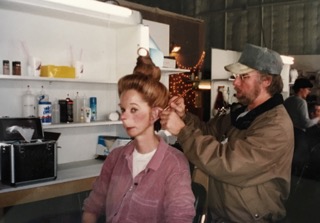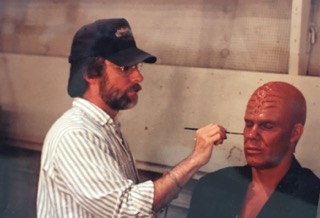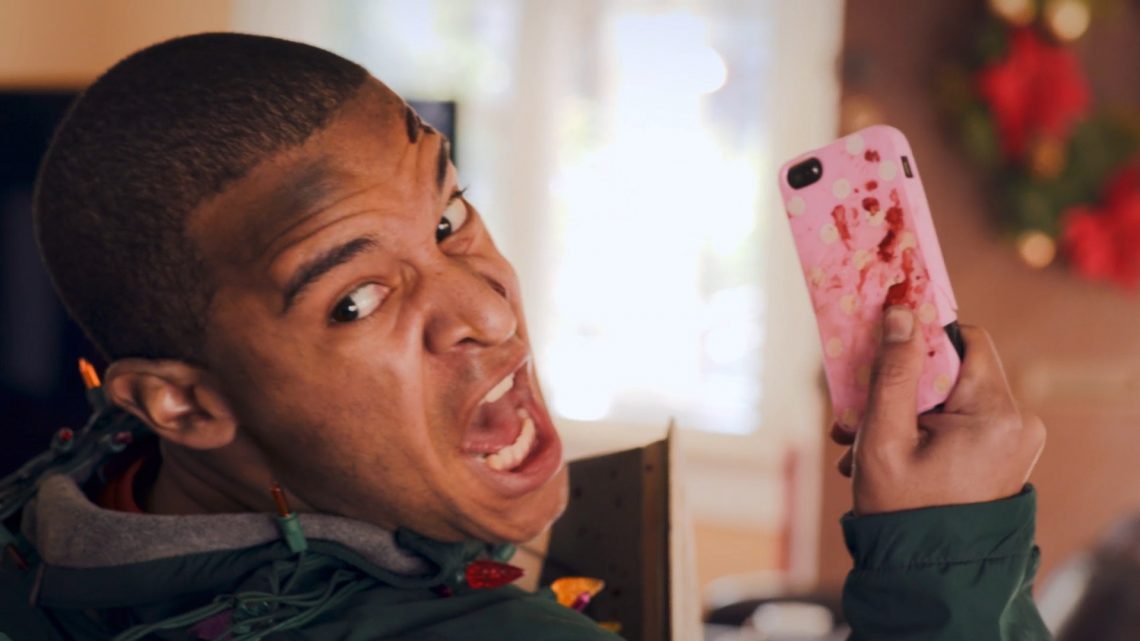What do projects such as Batman Returns, The Rocketeer, Dad, Death Becomes Her, Star Trek: Voyager, How the Grinch Stole Christmas, A.I. Artificial Intelligence and Tropic Thunder all have in common? Oscar nominated and two time Emmy winning make-up artist Greg Nelson. To say that Nelson is a veteran in the industry is an understatement, as he has worked on some of the most memorable characters in the last four decades including Danny Devito as the Penguin in Batman Returns and Roxann Dawson as Lieutenant Torres in Star Trek: Voyager. Nelson’s latest project, the upcoming horror/comedy Mercy Christmas directed by his nephew Ryan Nelson, once again pushed his skills to the max as he was called on to create bloody and charcoaled heads along with several other body cuts for the twisted flick. With such an expansive career, we spoke to him about some of his most memorable projects and the upcoming Mercy Christmas.
You have been a professional make-up artist for over 40 years now. How has your industry changed from when you first got started?
 I began my career working in TV doing beauty make-ups on shows for NBC. In the 80’s, I got my first big break working with Rick Baker on Michael Jackson’s “Thriller”. And from that point I did a lot of creature make-ups, old age make-ups and too many Ronald McDonald commercials to count. The biggest change I’ve noticed since I first started working in the early 70’s has been the technology as it applies to make-ups. CGI has taken the place of many of the character builds traditionally done by make-up artists. When I first started, “Planet of the Apes” movies were being made with make-up appliance work and prosthetics on actors. In the latest Apes movies, it’s all done with computers.
I began my career working in TV doing beauty make-ups on shows for NBC. In the 80’s, I got my first big break working with Rick Baker on Michael Jackson’s “Thriller”. And from that point I did a lot of creature make-ups, old age make-ups and too many Ronald McDonald commercials to count. The biggest change I’ve noticed since I first started working in the early 70’s has been the technology as it applies to make-ups. CGI has taken the place of many of the character builds traditionally done by make-up artists. When I first started, “Planet of the Apes” movies were being made with make-up appliance work and prosthetics on actors. In the latest Apes movies, it’s all done with computers.
You did some of the make up for Tim Burton’s Batman Returns. What was that experience like behind the scenes? How closely did you work with Tim?
Cold. I remember wearing parkas on the sound stage when it was one hundred degrees outside because they had the temperature way down so you could see the actor’s breaths. The Penguin’s lair was particularly cold because the scenes used a lot of real penguins in the water on that set. I didn’t really work with Tim Burton, Ve Neill make-up department head worked directly with him. But I remember Tim being very creative and also knowing exactly what he wanted. For my part, I had the most fun with Danny DeVito and assisting with the Penguin make-up. He’s a great guy.
A lot of filmmakers and critics have praised the makeup and vfx for Death Becomes Her, with many of them saying it was very advanced for the early 90s. Did you have any idea that what you were doing would become studied and held in such high regard? What did you specifically focus on in that film?
 I definitely knew when we were shooting that we were witnessing something new and different on that movie. It was pretty obvious because the camera did two passes on every shot so that they could layer the images and not to mention the motion capture camera equipment at that time was bigger than a car. My work on “Death Becomes Her” focused on Isabella Rossellini and Goldie Hawn. I was hired on that film because of my skills in beauty make-up and effects make-up. “Death Becomes Her” epitomizes the combination of both skills. I remember the end scene where the heads roll into frame that they put Goldie in a harness upside down to achieve it. We had to attach an appliance piece to her neck to make it looked severed from her body. That shot was all three elements: technology, effects and make-up.
I definitely knew when we were shooting that we were witnessing something new and different on that movie. It was pretty obvious because the camera did two passes on every shot so that they could layer the images and not to mention the motion capture camera equipment at that time was bigger than a car. My work on “Death Becomes Her” focused on Isabella Rossellini and Goldie Hawn. I was hired on that film because of my skills in beauty make-up and effects make-up. “Death Becomes Her” epitomizes the combination of both skills. I remember the end scene where the heads roll into frame that they put Goldie in a harness upside down to achieve it. We had to attach an appliance piece to her neck to make it looked severed from her body. That shot was all three elements: technology, effects and make-up.
You won an Emmy for Star Trek: Voyager. What are you most proud of with that show?
Again, I was hired because I could do both beauty and appliance work. My main focus was working on actress Roxann Dawson. She played Lieutenant Torres, a half human/half Klingon. I’m most proud of the episode “Faces” where her character is divided into both a full human and a full Klingon. Production had anticipated using split screen, but found it unnecessary because I was able to make her stand-in look enough like Roxann to use both her and the stand-in the same frame. Overall with the series, I was really proud of using make-up to help find the balance between human and Klingon for her character.
Your most recent project is the upcoming film Mercy Christmas being released on Nov 28. Can you tell us a little about your work on that film?
My nephew Ryan Nelson directed “Mercy Christmas” and co-wrote it with his wife Beth Levy Nelson. They asked me to help with the death scenes in the movie and some of the more gory aspects, which I was happy to do. I remember seeing Ryan’s home movies when he was in high school. He was always asking me for tips to make blood and how to create realistic make-up effects. It was fun to come full circle and be working with him on his first feature film. Ryan can speak the basic language of a make-up artist and understands what it takes to create a make-up. And both of us like to scare his dad, my brother, because unlike Ryan and I, he’s pretty squeamish when it comes to movie blood. I wouldn’t be surprised if Ryan was thinking of his dad as an audience when he designed the gory scenes.
Yes, the fire head. Ryan called me one night during the shoot and asked if I could do a burned head aftermath. I asked when he needed it and he said tomorrow morning. So, I didn’t have much time to plan, but in reality I’ve done many burns in my career and that wasn’t going to be an issue. The real problem was finding a bald cap in the middle of the night for the actor to wear the next morning. Luckily our make-up department head, Myla Kellerman had one at home. So the next morning, Ryan told me he needed to see third degree burns on the actor’s head, neck and hands and gave me two hours. I think it turned out pretty good. I know Ryan was happy.
Was there any specific hurdles or challenges you had to overcome on Mercy Christmas?
The butt cut. Ryan and I had discussed a butt cut during pre-production and whether we could pull it off realistically. Budget restrictions wouldn’t allow us to make a mold of the actor’s butt, fill it with gelatin and layered it with blood so that when it was cut on camera, blood would ooze out. We had to figure out a cheaper way. One day, I walked through my garage, saw a metal lampshade and thought hmmm… That could be a butt. I poured latex; made a butt cheek and we shot it in close up, no problem. Ryan was very intent on seeing the turkey carver break the skin and it worked out very well. So you never know.

